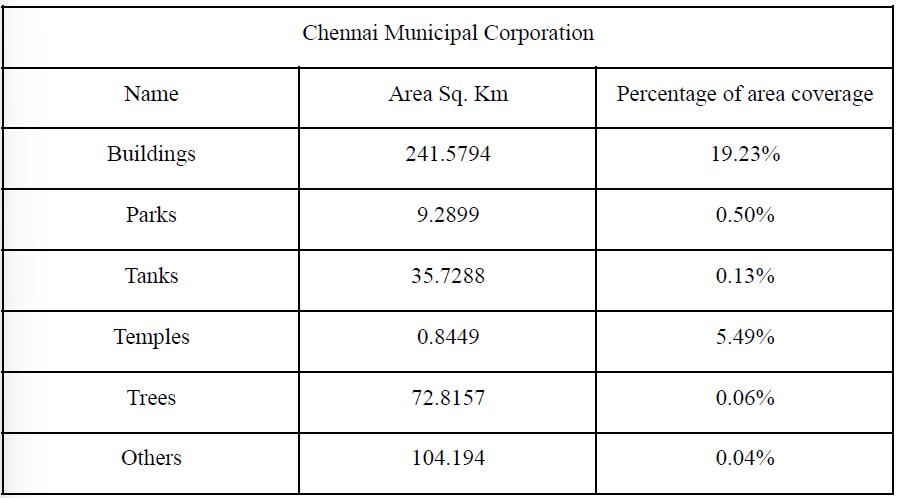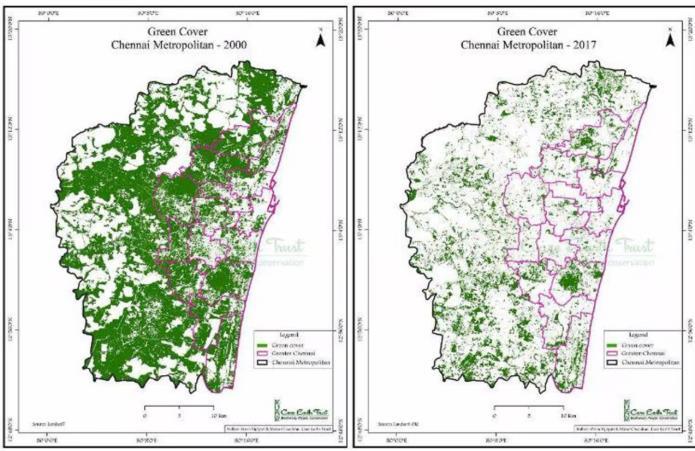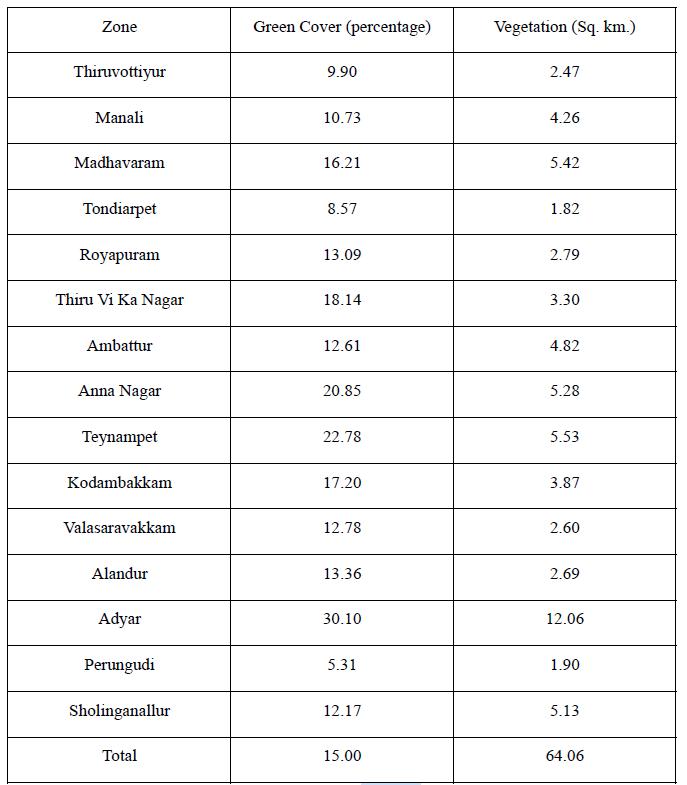
International Research Journal of Engineering and Technology (IRJET) e-ISSN: 2395-0056
Volume: 12 Issue: 01 | Jan 2025 www.irjet.net p-ISSN: 2395-0072


International Research Journal of Engineering and Technology (IRJET) e-ISSN: 2395-0056
Volume: 12 Issue: 01 | Jan 2025 www.irjet.net p-ISSN: 2395-0072
Inniya Arutchudar1 , Karthick S2
1Assistant Professor, Marg Institute of Design and Architecture Swarnabhoomi (MIDAS), Chengalpattu.
2Assistant Professor, Chettinad School of Architecture (CSOA), Chennai
Abstract - Greenery has always played an importantrolein the liveliness of any city. The need for green spaces has been present since ancient times. Due to undergoing urbanization trend worldwide, distance between city inhabitantsandnatureisincreasing. This will increasethe exposure to certain environmental hazards, such as air and noise pollution. Many urban areas face increasing pressure from expanding populations, limited resources and growing impacts of climate change. These challenges must be addressed especially in cities to provide healthy and sustainable living environment. Urban designsolutionsshould always consider both buildings and vegetation as being defining city’s elements. Urban greenery/forestry is one of the ways to bridge the gap between people and nature andto form asustainable environment. Most of the Indian cities are far behind in quality as well as quantity of urban forests than their counterpart in Europe and America. High population density is one of the reasons forunderdevelopment of urban greenery sector. India can learn a lot from Chinese model of urban forestry development as both of them are the topmost populated countries of the world. Recently, some of the Indian cities like Chandigarh, GandhinagarandDelhihave shown some improvement in this field. The benefits of green spaces in dense urban areas and their contribution for the sustainability of the cities are discussed below. This paper is also focused on Urban greeneries in Indian cities and steps taken to improve the green spaces. The paper concludes by discussing tree density in two areas of Chennaiandsuggesting recommendations to improve the same.
Key Words: Urban Greenery, Chennai, Sustainable environment,ClimateChange,UrbanForestry.
Thereareseveraltypesofgreenspacesinthecityandallof them have their own role in the urban context. These different types of greenery are present in different urban scaleswhichsolvesseveralfunctionsinthecity.Urbangreen infrastructureincludesdifferenttypesofblue-greenspaces such as forests, wetlands, agricultural land, public parks, privategardens,singlegreenelements(streettrees,green roofs,etc.)orpondsandstreams[1].Thepresenceofthese green spaces encourages the use of outdoor spaces, increasingtheinteractionamongcitizens.Indiaisurbanizing ataveryfastpace.Peoplemovetowardscitiesnotonlyfor employmentbutalsoforbettereducationfacilitiesprovided inurbanareaswhichcouldalsobeduetoincreaseinannual income.Allsuchactivitiescauseurbansprawl,noiseandair
pollution. The urbanization does not consider the importanceofurbanopenspaces.Thisrapidurbanizationis causingcongestionandpollutioninthecities[4].Itisclearly seen that the core urban area is heavily congested by concretejunglesandresultsinpollutions.Thedowntownof anareaisdenselypopulatedandthetotalnumberoftrees present there is totally reduced. These may cause several differenteffectsinfuture.Theenhancementofurbangreen spaces or urban forests is one of the ways, which has the potentialtomitigatetheadverseeffectsofurbanizationina sustainable manner, making cities more attractive and comfortable to live in. Conservation along with the developmentofgreenspaceshavebeenusedforalongasan essentialstrategytoreducetheconflictbetweenretaining the environmental quality and rapid urbanization [5]. Central and state governments in India are realizing the importance of urban green spaces in cities/towns. Greeneriesareconsideredonlyafterabigclimatechange.It shouldbethoughtwhileplanningbeforethecityexpands.
Cityisaclusterofpeopleandeachpersonneedacommon space for his leisure purpose and a green space to relax. Thoughthelifestyleofpeopleinacityisdevelopingalot,the stress and tension is also equally increasing to them. One reasoncanbethelifestylechangeandothermainreasoncan be due to the losing of green spaces which are the main supplierofoxygentohumanityandlackofopenspacesto relaxoneselfpersonally.Humanisthemainentityaffected by lack of green spaces other than environment. Environmentisfacingsevereimpactduetolosingofgreen spaceswithinthecities.Globalwarming,greenhousegases, increaseinurbanheatisland,increaseincarbonfootprint arethemajoreffectstoenvironmentduetogreencoverloss Currently many measures to increase and conserve green areas has been taken. The unsustainable consumption pattern of human had also led to scarcity of natural resources.Thehealthylivingofurbancommunityisgetting worsendaybyday.
Today54%oftheglobalpopulationislivinginurbanareas [2]andtheurbanpopulationisexpectedtocovermorethan two-thirdsoftheworldpopulationby2025 [3].Therapid increaseinpopulation,inconjunctionwithincreaseinthe rateofurbanization,hadledtounplannedanduncontrolled expansion of many towns. They have also resulted in the graduallossofopenspacesandgreenspacesinthecity.The green space development is one of unplanned process in mostpartofthecity.

International Research Journal of Engineering and Technology (IRJET) e-ISSN: 2395-0056
Volume: 12 Issue: 01 | Jan 2025 www.irjet.net p-ISSN: 2395-0072
Greenspacesystemplaysasignificantroleinbuildingupa lowcarboncityandensuringsustainabledevelopmentofa city.Althoughthelossofgreencoverisdirectlyaffectingthe environmental quality, the land inadequacy and rapid urbanizationprocessisalsoreducingthesizeofgreenspace which makes the urban planning, management and constructionaveryseriousprobleminthefuture.Assuming that total amount of green space is certain, utilizing the limited green space for enhancing environmental quality becomesaparamountgoalforurbangreenspaceplanning. Besides, the recreational and aesthetic values of green spacescanattracttouriststothecityandtherebycaninitiate employmentandrevenues[7].
Thegreenspacethatisavailableinanycityplayamajorrole inbufferingthehumanactivityandallurbantensions.Green spacesprovidenumerousenvironmentalservicesincluding noise reduction, air filtering, rainwater drainage, and microclimateregulation[6].Buttheexistingopenspacesare strugglingtomeetthepresentneedofboththehumanand environment. Hence consuming and preserving existing green spaces and proper planning of new open spaces is highlyneededinthepresentcontext.
Urbangreeneryisatermthatcanmeaneverything,fromcity parks and traditional streetscaping to more modern adaptations likegreen roofs etc. The varied range of green spacesincludesparks,urbanforest,urbanagriculture,street trees, residential lawns, garden, and yards that are either naturalorhumanmaintained[8].Therearecountlessways thatUrbanGreenerycanimproveoururbanareas.Themost obviousbenefit,ofcourse,ismorebeautifulcities!Butbeyond aesthetics, urban greenery has been shown to result incleaner air,safer neighborhoods andimproved storm water management. Urban greenery can be used as a connecting corridor between the neighborhoods. Trees, flowers and other plants can be woven to give the area an overallfeelingofaconsistenturbanfabric.Urbangreenery can be used as a tool to distinguish it from surrounding neighborhoods and highlighting its unique character. This approach would be even more effective when done in conjunction with other connectivity strategies such aswayfinding,tourismandstreetscapedesign.Greenspaces refer to those land uses that are covered with natural vegetationinthebuilt-upareasandplanningareas.
Thetermurbangreenerybroadlydefinedastheroleofurban vegetationincludingnotonlyopenspacesandparksbutalso residentialgardens,roofgardensandanyvegetationfoundin theurbanenvironment(MichaelDoherty,2005).
Greenspacesystemhasagreateffectontheurbanfeature. Only a good concordance between the man-made environmentandnaturalenvironmentcangenerateahuman settlement. As a recycling organization of urban ecological system,greenerieshavebeenprevalentlyconcernedbythe
society.Peopleinstinctivelyhaveuniquepsychologytogreen spacesatthebeginning.Manyscholarsconcernmoreonthe qualityofgreenspaceandtheirbenefits.Theyemphasizeon ecology,societyandeconomy.Thisresearchwillfocusonthe benefits of green spaces by using the major three classifications, including ecological benefits, social benefits andeconomicbenefits.
Trees can release oxygen and absorb carbon dioxide, thus balancingcarbonandoxygen.Ithasbeenmeasuredthat 1hectarebroadleavescanconsume1toncarbondioxideand release0.75-tonoxygeneverydayinthegrowingseason.Ifan adultresidentabsorbs0.75kgoxygenandreleases0.90kgof carbondioxideeveryday,thebalancebetweencarbonand oxygenforonepersonwillneed10sq.mforestryormorethan 25sq.mlawntomaintain[9].Basedonthis,somecountries determined that green per capita should be 40 sq.m when planningtheurbangreeneries.
Therearemoreandmoretoxicgasesexistingintheairwith the improvement of industrial level. Under some concentrations many kinds of vegetation can absorb toxic gasesintotheirbodiestotransferthemintonon-toxicgasesor excludethosetoxicgasesoutoftheirbodies.
Table -1: FewtreespeciesandtheirBenefits
TREE SPECIES
POLLUTANTS ABSORBED OTHER BENEFITS
English Oak Nitrogen dioxide, Sulphur dioxide,Particulatematter
Eastern White Pine
Red Maple
Honey Locust
Green Ash
Ozone, Nitrogen dioxide, Sulphur dioxide, Particulate matter
Ozone, Nitrogen dioxide, Particulatematter
Particulate matter, Carbon monoxide
Ozone,Particulatematter
Provideshabitatfor wildlife
Reduces noise pollution
Tolerates urban environments
Providesshadeand reduces energy consumption
Tolerates a wide rangeofsoiltypes
As such, vegetation can play a cleaning function to air pollutions.Silverbirch,Yewandeldertreesaremosteffective at capturing particles with the hairs of their leaves contributing to reduction rates of 79%, 71% and 70% respectively.Incontrast,nettlesemergedastheleastusefulof thespeciesstudied,thoughtheystillcapturedarespectable 32%.Conifers,likepinesandcypresses,arealsogoodnatural purifiers[10].

International Research Journal of Engineering and Technology (IRJET) e-ISSN: 2395-0056
Volume: 12 Issue: 01 | Jan 2025 www.irjet.net p-ISSN: 2395-0072
Vegetationcanreducethefearofcrime.Thepresenceoftree or greeneries can lower stress and thus reduce crime. Comparingbuildingswithdifferentlevelsofvegetation,those with high levels of vegetation recorded 52% fewer total crimes,48%fewerpropertycrimes,and56%fewerviolent crimes than buildings with low levels of vegetation[11]. Urbanstreettresscreatesverticalwallsthatframestreetsand provideadefinededgethatcanhaveanimportanteffecton driversandespeciallymotoriststoreducespeed,andgivea better distinction between drivers and pedestrians. In addition, street trees can help reduce stress by relieving anxietyanddepression.Itcanimprovethementalhealthand quality of life among inhabitants. [11] Street trees also increase pedestrian safety because in the case of driving errors,theyhelptostopthedriverfromaccidentallytakinga humanlife.
Greeneries can play a major role in generating economy through Tourism. Creation of new greeneries like forest, parks can attract new visitors. China, a country which is facingpopulationexplosionlikeIndiahasgivenimportance tourbangreeneries.CitiesinChinalikeChangchun,Nanjing andGuangzhouhasagreencoverofmorethan40%.China has a goal of expanding its green cover to 45% in 70% of their cities by 2050 [12]. Tourism is growing more in Chandigarh and Zakir Rose garden, an annual festival of gardensisplannedineveryFebruary[13].Touristsaround nearby areas of Chandigarh enjoy this very much. These greeneriesareusedbymanypeopleforrecreationpurposes like active recreation such as skateboarding, sports, swimmingetc.,andpassiverecreationlikewatchingaview, readingbooks,relaxingorinteracting.Thisinvolvespeople to rest in a particular place or travel to a place which providesthesebenefitswillincreasetourisminanycity.
New Delhi, capital of India has many restrictions in greeneriesacross thecity.Atpresent20%ofDelhihasits greencovermakingitspercapitagreenspaceof22m2.City has good parks and gardens like Lodhi garden, Mughal Garden, Deer Park, Budha Jayanthi Smarak Park, Indraprashtha Park and the Grden of Five senses. Department of Environment and Forest of NCT, Delhi is responsible for increasing the green cover from 30km2 to 300km2duringlast10years[14].Gandhinagarprojecthasa total area of 57km2. By the year 2005, tree cover of Gandhinagarwas57.13%ofaround32.56km2.Populationof the city was 0.2 million in 2001, resulting in 160 m2 per capita green space. Population of the city is 0.3 million in 2011.Duringthis time, the varietiesoftreespeciesislow comparedtoBangaloreandChandigarh.Semi-aridclimatic conditionscanbethemajorreasonforthissituation[15].
Table -2: ImportantIndiancitieswithPercapitagreenspace

Chandigarhcityhasageographicalareaof35%undergreen coverwhichmakesitagreenestcityofIndia[16].Population ofthecitywas0.9millionin2001,makingpercapitagreen space as 55m2 [Table 2]. Important parks are like Rose Garden,Bougainvillea Garden,Garden of fragrance, shanti Kunj,HibiscusGarden,BotanicalGardenandleisureValley. BangalorecityiscalledasGardencityofIndiaduetomany private gardens, roadside and avenue trees and the magnificentLalbaghandCubbonPark.Thecityhasatotalof 705parks.Besidesthese,therearearound200openspaces andgreenareaswhichareplannedtodevelopasparksand gardens [17] Estimated crown cover of the city is about 19.9%ofthegeographicalarea.Thisamountsapercapita greenspaceof19.9%ofthegeographicalarea[Table2].But reports by Karnataka state remote sensing applications suggestsaconsiderabledecreaseintheoverallvegetationof the city. In Jaipur city, the area covered under parks is around5.43km2forapopulationof2.32million,makingper capitaavailabilityof2.30m2[table2].Thisisverylowasper WorldHealthorganizationnormsof9.0m2 greenspaceper city dweller [18]. Most of the Indian cities except Gandhinagar and Chandigarh are far behind in per capita greenspaceavailability.
Chennai, the capital city of Tamil Nadu has a population of 11,235,018 [19]. Due to well-established industries and factories, it contributes the most to the economy of Tamil Nadu [20]. Due to population explosion and rapid urbanization,Chennaihasalotofpollution.Thisaffectsthe greeneryofthecity.Chennaihasanoverall0.50%ofparks which is 9.3 sq.km in area and 0.06% of tree cover which contributesto72.8sq.kmofitsarea[21][Table3].
Table -3: Percentagecoverofbuildings,parks,trees, temples,tanksinChennai.


International Research Journal of Engineering and Technology (IRJET) e-ISSN: 2395-0056
Volume: 12 Issue: 01 | Jan 2025 www.irjet.net p-ISSN: 2395-0072
Thepercentageoftrees,parksandtankscoveratotalofless than1%ofthetotalareabutbuildingscontributeto19%of thetotalarea.Chennaihasmorethan500parksthatcomes under public green area, maintained by Greater Chennai Corporation. Among many national parks the well-known Guindy National Park is located in the city [22]. Other importantparksincludePeople’sPark,HuddlestonPark,may dayParketc.,Around2000,Chennaihasrecordedmoregreen cover[23] Educational Institutions like IndianInstitute of technology(IIT,madras),collegeofengineering,Guindyand madras Christian College, have a great green space and consideredtobethegreentanksofChennai[24].Botanical Park ofChennai built around2010,MadhavaramBotanical gardenswhichisalsoahorticultureparkisspreadacross8 hectares.Around2017,thegreencoverofChennaihasbeen considerably reduced compared to 2000 [25]. Mostly individual residential spaces, institutions and bigger parks onlyhavetheleft-overgreeneries.
Chennaihasavarietyofgreenspacesfromlandscapesaround individualbuilding,parks,gardens,wetlandsandavenueof trees along the streets. When talking about tree density, Chennai has more of its trees along streets. According to a studyin2020,Chennai’s Teynampethas moregreencover percentageof22.78%whichoccupies5.53sq.kmofthetotal area. The smaller number of green covers was found in Perungudiof5.31%whichcovers1.9sq.kmofthetotalarea [26] [Table 4]. Green cover can be assessed between two areasinChennai.Aminjikarai,thelessgreencoverofChennai andAnnaNagar,oneoftheareaswithmoregreencoverin Chennai.BoththeseareascomeunderthesameAminjikarai Talukwithabigdifferenceintheirgreencover.Boththese areasliearoundthebanksofRiverCooum.
AminjikaraiknownbyitsnameasAmaindakaraiisone of the oldest localities of Chennai. It was under the Madras districtfrom1946.Aminjikaraihasitsgreencoveralongfew roadsandalsoalongtheCooumriver.Sincethisisaveryold settlement,thebuildingsmostlyaresemi-attachedwallto wall constructions with mostly buildings of two storey height. Theamountofgreencoverpercentageisaround2% withavegetationofaround0.4sq.kmofthetotalarea[26].

Table -4: Percentageofgreencoverandsquare kilometersofvegetationacrossChennai.

AnnaNagar,whichcanbeknownasNaduvakarai,whichis locatedunderAminjikaraitaluk.Thisisoneoftheresidential areasofChennai.AnnaNagarwasdevelopedbytheTamil NaduHousingBoardintheearly1970sfollowingtheWorld trade Fair in the area in 1968. The board developed residential plots, apartments, commercial spaces, wide roads,institutions,busterminusandparks.AllroadsofAnna Nagararecoveredbyavenueoftrees.AnnaNagarisaplace wherebuildingsaredetachedasinaplotteddevelopment. Thisisthemajorreasonbehindthetreedensitydifference betweennearbyareasofAminjikaraiandAnnaNagar.
Indiancitiesmostlyfaceaseriousissueofcuttingdownof treesmainlyduetoexpansionofroads.Areasespeciallyin Chennaialsofacethesameissue.Treescanbetransplanted into some other place before cutting especially the older trees. Trees are also damaged due to construction of buildings in any plots or in an area. Tree protection Zone (TPZ)isanareathatissurroundingthetreetoprotectthem fromconstructionanddevelopment.TPZisdeterminedby thediameterofthetreeatbreastheight,whichis1.4mabove ground level. TPZ is calculated by multiplying DBH by 12, which gives the radius of TPZ [27]. This is important to protect the trees starting from their roots. Trees or greeneriesshouldbeprotectedbyastrongfence.

International Research Journal of Engineering and Technology (IRJET) e-ISSN: 2395-0056
Volume: 12 Issue: 01 | Jan 2025 www.irjet.net p-ISSN: 2395-0072
Thepresenceofgreeneryinanareawillincreaseitsvalueby 4-15%dependingonlocalconditions[28].Reserving10% areas in every plot can increase the greenery. Greenery makesanareamoreattractiveandencouragesresidential and business to move into it. Crime will also be lesser in these areas. Green roofs and facades can be an important linktogreenerenvironments.City-dwellerswhoresidenear green environments are away from the noise pollution Urbangreenerycanbepromotedinurbanenvironmentsin the form of green roofs, green walls, courtyards, rooftop gardens.Treesandgreeneriesgivemanypositiveeffectsto citiestodaywhichfacesmanycrucialchallenges.
[1] https://climateadapt.eea.europa.eu/en/metadata/adaptationoptions/green-spaces-and-corridors-in-urban-areas
[2] https://unhabitat.org/world-cities-report-2016
[3] M.Roy,“Planning for sustainable urbanisation in fast growing cities: Mitigation and adaptation issues addressedinDhaka,Bangladesh,” HabitatInternational, Volume33,Issue3,pp.276-286,July2009
[4] J.R.Wolch(et.al.,),“Urbangreenspace,publichealth,and environmental justice: The challenge of making cities just green enough,” Landscape and Urban Planning, Volume125,pp.234-244,May2014
[5] Li-Yin-Shen (et.al.,), “The application of urban sustainability indicators – A comparison between various practices”, Habitat International, Volume 35, Issue1,pp.17-29,January2011.
[6] Barbara Szulczewska (et.al.,), “How much green is needed for a vital neighbourhood? In search for empiricalevidence”, LandUsePolicy, Volume38,pp.330345,May2014.
[7] K.Irvine(et.al.,),“Understandingurbangreenspaceasa health resource: a qualitative comparison of visit motivation and derived effects among park users in Sheffield,UK”,IntJEnvironResPublicHealth,2013.
[8] M.M.Hassan (et.al.,), “ Examination of land use/land cover changes, urban growth dynamics, and environmental sustainability in Chittagong city, Bangladesh, Environment, development and sustainability, May2015.
[9] https://iee.psu.edu/news/blog/how-many-trees-areneeded-take-carbon-dioxide-i-release-every-day
[10] https://citygreen.com/the-best-tree-species-forreducing-air-pollution/
[11] Wolf,K.L. Crime and Fear - A Literature Review. In: Green Cities: Good Health (www.greenhealth.washington.edu). CollegeoftheEnvironment,UniversityofWashington, 2010.
[12] Liu, C., Shen, X., Zhou, P., Che, S. and Zhang, Y. (2004) ‘UrbanForestryinChina:statusandprospects’, Urban Agriculture Magazine,No13,pp,1-17.
[13] Technopack,K.S.A.(2003)‘Urgetosplurge’, IndiaToday (weeklymagazine),9June2003.
[14] PradeepChaudhry.,Kenjumbagra.,BilasSingh,‘Urban Greenery status of Some Indian Cities: A short Communication’,InternationalJournalofEnvironmental ScienceandDevelopment,Vol.2,No.2,April2011.
[15] Forest Department Gujarat, tree cover assessment in Gandhinagarcapitalprojectarea,usingremotesensing technology, Report prepared by GIS centre, Forest department,Gujarat,2008.
[16] ActionPlan,GreeningChandigarh,Annualplan,Forest Department, 2099-10, Chandigarh Administration, Chandigarh.
[17] Gowda, K., Sridhara, M.V, and Rajan, S. Planning ana management of parks and green area: The case of Bangalore metropolitan area. Management of EnvironmentalQuality,2008,pp270-282.
[18] Shanker,V.S.,Pandey,D.N.,Gupta,A.KandRavindranath, N.H.,Climatechangeimpacts,mitigation&adaptation. ScienceforgeneratingpolicyoptionsinRajasthan,India. RSPCBoccasionalpaperno2/2010.www.rpcb.nic.in
[19] ChennaiPopulation(n.d.).RetrievedMarch23,2021.
[20] Sukumar, V. Sustainability needs a people-centric approach;issmartcityChennaigearedtothat?Citizen matters,2019.
[21] Gandhi, M.G., Thummal, N., & A,c. ‘Urban green cover assessmentandsiteanalysisinChennai,Tamilnadu–A remote sensing and GIS approach’. ARPN Journal of enginneringandAppliedsciences,pp2239-2243,2015.
[22] Kumar, K.K.S., Anneboina, L.R., Pattanayak, A., Balasubramanian,A.,Sheshadri,S.,Nath,M.,&Sharan,A. ‘State of Environmental report for Tamil nadu. GovernmentofTamilNadu,198.
[23] HarshithaSatish,KshreerajaSatish.,‘GreenCity:ACase Study of Chennai’ International Journal of Policy SciencesandLaw,Vol1,Issue4,pp1957-1974.
[24] VenkatramanA.,‘ThemostBeautifulandgreenSoacesin Chennai.Culturetrip,2017.

International Research Journal of Engineering and Technology (IRJET) e-ISSN: 2395-0056
Volume: 12 Issue: 01 | Jan 2025 www.irjet.net p-ISSN: 2395-0072
[25] PremSylester.,‘WhyChennaineedsgreenerytypicalto itslandscapeandnotexoticspecies’,TheNewsminute, 2017.
[26] Baraasu, R. ‘Breathe easy, Corpn’s mini Miyawaki Junglestocomeupineveryzonesoon,DTNext,2021.
[27] RyanRoche.,FutureHealthTreeReports,‘WhatisaTree ProtectionZone(TPZ).
[28] Hiemstra.,J.A.,DeVries.,Spijker.,‘Urbangreenery:More than beauty and health’., Wageningen University.
BIOGRAPHIES


Ar.InniyaArutchudarJosephineis an Assistant Professor, in Architecture. She has 5 years of experience in this field. She is interested in Urban design, greeneryandenergyefficiency.
Ar.Karthick,apassionatearchitect andeducatorwithoverthreeyears ofteachingexperience,specializes in Building Information Modeling (BIM)anddigitalarchitecture